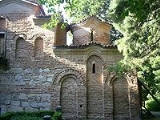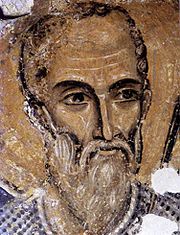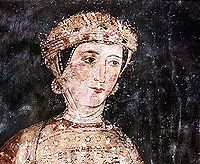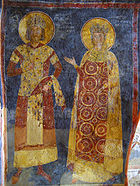
Boyana Church
Encyclopedia



Middle Ages
The Middle Ages is a periodization of European history from the 5th century to the 15th century. The Middle Ages follows the fall of the Western Roman Empire in 476 and precedes the Early Modern Era. It is the middle period of a three-period division of Western history: Classic, Medieval and Modern...
Bulgarian Orthodox
Bulgarian Orthodox Church
The Bulgarian Orthodox Church - Bulgarian Patriarchate is an autocephalous Eastern Orthodox Church with some 6.5 million members in the Republic of Bulgaria and between 1.5 and 2.0 million members in a number of European countries, the Americas and Australia...
church situated on the outskirts of Sofia
Sofia
Sofia is the capital and largest city of Bulgaria and the 12th largest city in the European Union with a population of 1.27 million people. It is located in western Bulgaria, at the foot of Mount Vitosha and approximately at the centre of the Balkan Peninsula.Prehistoric settlements were excavated...
, the capital of Bulgaria
Bulgaria
Bulgaria , officially the Republic of Bulgaria , is a parliamentary democracy within a unitary constitutional republic in Southeast Europe. The country borders Romania to the north, Serbia and Macedonia to the west, Greece and Turkey to the south, as well as the Black Sea to the east...
, in the Boyana
Boyana
Boyana is a neighbourhood of the Bulgarian capital of Sofia, part of Vitosha municipality and situated 8 km south of the city centre, in the outskirts of Vitosha. Boyana is typically regarded as one of the best and most expensive neighborhoods of Sofia to live in...
quarter. The east wing of the two-storey church was originally constructed in the late 10th or early 11th century, then the central wing was added in the 13th century under the Second Bulgarian Empire
Second Bulgarian Empire
The Second Bulgarian Empire was a medieval Bulgarian state which existed between 1185 and 1396 . A successor of the First Bulgarian Empire, it reached the peak of its power under Kaloyan and Ivan Asen II before gradually being conquered by the Ottomans in the late 14th-early 15th century...
, the whole building being finished with a further expansion to the west in the middle of the 19th century.
The church owes its world fame mainly to its fresco
Fresco
Fresco is any of several related mural painting types, executed on plaster on walls or ceilings. The word fresco comes from the Greek word affresca which derives from the Latin word for "fresh". Frescoes first developed in the ancient world and continued to be popular through the Renaissance...
es from 1259. They form a second layer over the paintings from earlier centuries and represent one of the most complete and well-preserved monuments of Eastern Europe
Eastern Europe
Eastern Europe is the eastern part of Europe. The term has widely disparate geopolitical, geographical, cultural and socioeconomic readings, which makes it highly context-dependent and even volatile, and there are "almost as many definitions of Eastern Europe as there are scholars of the region"...
an mediaeval art. A total of 89 scenes with 240 human images are depicted on the walls of the church. The name of the painter is recently discovered during restoration. The inscription reads: "zograph Vassilii from the village Subonosha, Sersko and his apprentice Dimitar".
National Museum of History
National Museum of History
The National Museum of History is located in the Nanhai Academy in Zhongzheng District, Taipei, Taiwan and exhibits Chinese historical items...
director Bozhidar Dimitrov
Bozhidar Dimitrov
Bozhidar Dimitrov Stoyanov is a well-known Bulgarian historian working in the sphere of Medieval Bulgarian history, the Ottoman rule of Bulgaria and the Macedonian Question...
stated: "The renovation revealed a rare inscription under a layer of plaster on one of the church walls: 'I, Vasiliy' inscribed. We now know the painter with certainty. The 13th-century 'Boyana master' was the only painter among the kings and nobles whose names were read out on a regular basis during sermons at the church." Restorator Grigoriy Grigorov stated the reason: "The Christian Orthodox religion forbids the painter from manifesting himself, as in the eyes of the priests it is God who guides his hand. But this painter inscribed his name, knowing that the believers could not see it."
18 scenes in the narthex
Narthex
The narthex of a church is the entrance or lobby area, located at the end of the nave, at the far end from the church's main altar. Traditionally the narthex was a part of the church building, but was not considered part of the church proper...
depict the life of Saint Nicholas
Saint Nicholas
Saint Nicholas , also called Nikolaos of Myra, was a historic 4th-century saint and Greek Bishop of Myra . Because of the many miracles attributed to his intercession, he is also known as Nikolaos the Wonderworker...
. The painter here drew certain aspects of contemporary lifestyle. In The Miracle at Sea, the ship and the sailors' hats recall the Venetian
Venice
Venice is a city in northern Italy which is renowned for the beauty of its setting, its architecture and its artworks. It is the capital of the Veneto region...
fleet. The portraits of the patrons of the church — Sebastocrator Kaloyan
Kaloyan (sebastocrator)
Kaloyan was a 13th-century Bulgarian noble, sebastocrator of Sredets and the surrounding region during the Asen dynasty of the Second Bulgarian Empire....
and his wife Desislava, as well as those of Bulgarian tsar Constantine Tikh
Constantine Tikh of Bulgaria
Constantine I , which includes the shortened form of the name of his father as a patronymic), ruled as emperor of Bulgaria from 1257 to 1277....
and Tsaritsa
Tsaritsa
Tsaritsa , formerly spelled czaritsa , is the title of a female autocratic ruler of Bulgaria or Russia, or the title of a tsar's wife....
Irina, are thought to be among the most impressive and lifelike frescoes in the church, and are located on the north wall of the church.
Besides the first layer of 11th-12th century frescoes, of which only fragments are preserved, and the famous second layer of murals from 1259, the church also has a smaller number of later frescoes from the 14th and 16th-17th century, as well as from 1882.
The monument was added to the UNESCO
UNESCO
The United Nations Educational, Scientific and Cultural Organization is a specialized agency of the United Nations...
World Heritage List in 1979. The frescoes were restored and cleaned in 1912-1915 by an Austria
Austria
Austria , officially the Republic of Austria , is a landlocked country of roughly 8.4 million people in Central Europe. It is bordered by the Czech Republic and Germany to the north, Slovakia and Hungary to the east, Slovenia and Italy to the south, and Switzerland and Liechtenstein to the...
n and a Bulgarian specialist, as well in 1934 and 1944. The church was closed for the public in 1977 in order to be conservated and restored and once again opened in 2000.
The church patrons' inscription in Middle Bulgarian from 1259 reads:http://www.boyanachurch.org/pictures/gallery/pic8s.jpg
{cquote|This immaculate temple of the Holy hierarch Nicholas
Saint Nicholas
Saint Nicholas , also called Nikolaos of Myra, was a historic 4th-century saint and Greek Bishop of Myra . Because of the many miracles attributed to his intercession, he is also known as Nikolaos the Wonderworker...
and martyr Panteleimon
Saint Pantaleon
Saint Pantaleon , counted in the West among the late-medieval Fourteen Holy Helpers and in the East as one of the Holy Unmercenary Healers, was a martyr of Nicomedia in Bithynia during the Diocletian persecution of 303 AD...
was erected from the ground and created with the funds, care and great love of Kaloyan
Kaloyan (sebastocrator)
Kaloyan was a 13th-century Bulgarian noble, sebastocrator of Sredets and the surrounding region during the Asen dynasty of the Second Bulgarian Empire....
, sebastokrator, cousin of the Tsar
Tsar
Tsar is a title used to designate certain European Slavic monarchs or supreme rulers. As a system of government in the Tsardom of Russia and Russian Empire, it is known as Tsarist autocracy, or Tsarism...
, grandson of Saint Stephen
Stefan Nemanja
Stefan Nemanja was the Grand Prince of the Grand Principality of Serbia from 1166 to 1196, a heir of the Vukanović dynasty that marked the beginning of a greater Serbian realm .He is remembered for his contributions to Serbian culture and...
, King of Serbia. This was written in the Bulgarian Empire under the pious and devout Tsar Constantine Asen
Constantine Tikh of Bulgaria
Constantine I , which includes the shortened form of the name of his father as a patronymic), ruled as emperor of Bulgaria from 1257 to 1277....
. Indiction
Indiction
An indiction is any of the years in a 15-year cycle used to date medieval documents throughout Europe, both East and West. Each year of a cycle was numbered: first indiction, second indiction, etc...
7 of the year 6767 [1259].}}
Architecture
The Boyana Church was built in three stages: in the late 10th and early 11th, the mid-13th, and the mid-19th centuries.The oldest section (the eastern church) is a small one-apse cross-vaulted church with inbuilt cruciform supports. It was built in the late 10th and early 11th century.
The second section, which adjoins the eastern church, was commissioned by Sebastocrator Kaloyan and his wife Dessislava and in the mid-13th century. This building belongs to the two-floor tomb-church type. It consists of a ground-floor family sepulchre with a semi-cylindrical vault and two arcosolia on the north and south walls, and an upper-floor family chapel identical in design to the eastern church. The exterior is decorated with ceramic ornaments.
The last section was built on donations from the local community in the mid-19th century.
First layer

Second layer
According to the donor’s inscription on the north wall of the second section, the second layer of frescoes dates from 1259. Those frescoes were painted over the earlier layer by a team of unknown artists, who also decorated the two floors of the building commissioned by Sebastocrator Kaloyan.The Boyana Church owes its world fame above all to the frescoes from 1259, which demonstrate the exceptional achievements of mediaeval Bulgarian culture. The majority of the more than 240 figures depicted here display individuality, remarkable psychological insight and vitality. The frescoes follow the canon of icon-painting established by the Seventh Ecumenical Council held in Nicaea in 787.
The frescoes in the oldest section of the church include a magnificent representation of Christ Pantocrator in the dome. The drum below shows a host of angels, with the Four Evangelists - Matthew, Mark, Luke and John - portrayed in the pendentives. Four images of Christ adorn the face of the arches: Christ Emmanuel; Christ, The Ancient of Days; and the acheiropoietic (“made without hands”) Holy Mandylion and Holy Tile. Next come scenes from the Major Feast Days and the Passions of Christ. Among the full-length portrayals of saints in the first tier, there are ten warrior saints. The Virgin Enthroned, surrounded by archangels, is represented in the altar conch. Below are four church fathers: St. Gregory the Theologian, Basil the Great, John Chrysostom and Patriarch Germanus. The frescoes flanking the altar show the deacons Laurentius, Euplius and Stephen, as well as St. Nicholas, the patron of the ground floor of the church - one of the most popular saints and the patron saint of sailors, merchants and bankers.
The life of St. Nicholas is depicted in 18 scenes in the narthex (the second section of the church). The unknown artist included elements of contemporary life in those scenes, and many of the figures are quite realistic - especially their countenances. The lunette above the entrance of the narthex displays the Virgin and Child, St. Anna and St. Joachim, and Christ Blessing. St. Catherine, St. Marina, St. Theodore the Studite and St. Pachomius are portrayed in the lower tiers on the walls. The south arcosolium features the scene of Christ Disputing with the Doctors, and the north one, the Presentation of the Virgin. Two highly revered Bulgarian saints are also represented in the narthex - St. John of Rila (the oldest surviving representation of the saint) and St. Paraskeva (Petka). The hermit St. Ephraim Syrus appears among the monks portrayed here. The expressive realistic portraits of the donors
Donor portrait
A donor portrait or votive portrait is a portrait in a larger painting or other work showing the person who commissioned and paid for the image, or a member of his, or her, family...
Sebastocrator Kaloyan and his wife Dessislava, and of the Bulgarian Tsar Constantine Asen Tikh and Tsaritsa Irina - painted with precision, extraordinary skill and feeling - are among the oldest portraits of figures from Bulgarian history.
Today the name “Boyana Master” stands for the team of unknown artists who decorated the church and mastered their art in the studios of the Turnovo School of Painting. The frescoes are genuine masterpieces with a flawless technique, psychological depth, complexity and realism. Boyana is the only and the most impressive wholly preserved monument of the Turnovo School of Painting from the 13th century.
According to many leading experts, the world famous frescoes in the Boyana Church played an important role in the development of mediaeval Bulgarian and European painting.
Late frescoes
Some parts of the church were overpainted, and the majority of those frescoes have survived to the present day.The later frescoes include a scene of the Presentation of the Virgin from the 14th century, a portrait of St. Nicholas from the 16th-17th century, and representations of the two patron saints of the Boyana Church - St. Nicholas and St. Panteleimon - from 1882.
Full restoration
The Boyana Church was officially opened in the February 10, 2008 official ceremony which formally ended the (2006-2008) 400,000 leva ( 200 000 EUR) restoration works, with funding of the initiative "The eternal buildings of BulgariaBulgaria
Bulgaria , officially the Republic of Bulgaria , is a parliamentary democracy within a unitary constitutional republic in Southeast Europe. The country borders Romania to the north, Serbia and Macedonia to the west, Greece and Turkey to the south, as well as the Black Sea to the east...
". The Church has now an air-conditioning system to keep the temperature at 17-18 degrees Celsius (62-64 Fahrenheit), while the special lighting system does not emits heat, and visitors are only allowed 15 minutes for entries. Currently under the management of the National Museum of History
National Museum of History
The National Museum of History is located in the Nanhai Academy in Zhongzheng District, Taipei, Taiwan and exhibits Chinese historical items...
, Culture Minister Stefan Danailov
Stefan Danailov
Stefan Lambov Danailov is a Bulgarian actor and former Minister of Culture of Bulgaria .The first film Danailov has taken part was "The Traces Remain" being a child. At that time he did not want to be an actor. However, later in 1966 he graduated VITIZ...
marked its full opening on October 2, 2008. It is now open 7 days a week from 9:30 am to 17:30 pm, with admission of 10 leva per person.

